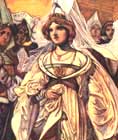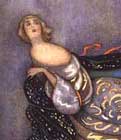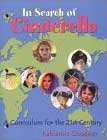
Cinderella:
345 Variants
by Marian
Roalfe Cox
SurLaLune's
Cinderella Area
SurLaLune Fairy Tales Main Page
236
Grimm, Household Tales. Translated by Margaret Hunt. London, 1884. Vol. ii, pp. 169-176. No. 130. (From Upper Lusatia. Taken from Busching's Wochentliche Nachrichten, ii, 17-26.)
"ONE-EYE, TWO-EYES, AND THREE-EYES."1
[You can read Hunt's translation of One-Eye, Two-Eyes, and Three-Eyes on SurLaLune.]
ABSTRACT
Ill-treated heroine (by mother and elder and younger sisters)--Menial heroine (tends goat)--Wise aid--Helpful animal (goat) gives food. One-eye sent to spy on heroine, who charms her to sleep. Three-eyes sent to spy; heroine omits to charm third eye which discovers magic food supply--Slaying of helpful animal. Heroine buries entrails; tree with silver leaves and gold fruit springs from them--One-eye and Three-eyes climb tree but cannot pluck fruit, which escapes their hands. Heroine picks gold apples. Knight draws near to admire tree; heroine is pushed under empty barrel. He promises to grant any wish to one who can pluck him branch. One-eye and Three-eyes try and fail. Heroine rolls two gold apples from under barrel to his feet. She is brought forth; plucks him branch from tree, and begs to be taken from unhappy home--Happy marriage--Magic-tree removes to heroine's new home. She befriends sisters in after years.
TABULATION
(1) Woman has three daughters, eldest called "One-eye", having only one eye in middle of forehead; second, "Two-eyes"; youngest, "Three-eyes", whose third eye is in the middle of forehead. Two-eyes is hated by mother and sisters for being like other people. They ill-treat her, give her old clothes, and, for food, their leavings. Two-eyes goes to field to tend goat, and cries from hunger till two streams run down from her eyes.-- (2) Looks up and sees wise woman, who, learning why she weeps, bids her dry her eyes and say to goat:
"Bleat, my little goat, bleat,
Cover the table with something to eat."
Then a well-spread table will appear with delicious food, which she shall cat, and then say:
"Bleat, bleat, my little goat, I pray,
And take the table quite away."
Then the table will vanish. Wise woman departs, and heroine does as bidden, and, after saying grace, enjoys feast. In the evening she takes goat home, and finds small earthenware dish with food sisters have left 1her; but she does not touch it. Next day she goes with goat, leaving untouched the scraps of bread offered her.-- (3) First and second time she does this no notice is taken, but presently sisters suspect she has other food-supply, and One-eye goes to field to spy on her. Heroine sings:
"One-eye, wakest thou?
One-eye, sleepest thou?"
till One-eye falls asleep. Then heroine works the food-charm as before. She afterwards wakes One-eye, taunts her with sleeping instead of minding goat, and they return together. Heroine again leaves food untouched, and One-eye confesses to mother that she fell asleep, and failed to discover anything. Next day mother sends Three-eyes with heroine. They sit down, and heroine sings:
"Three-eyes, are you waking?"
and, instead of singing:
"Three-eyes, are you sleeping?"
she adds by mistake:
"Two-eyes, are you sleeping?"
So only two eyes really sleep, the third pretends, and watches whilst heroine uses her charm.-- (4) They return home, and when mother hears Three-eyes' story, she fetches butcher's knife and kills goat. Two-eyes goes to field, weeping bitterly. Wise woman appears, and bids her ask for entrails of slaughtered goat, and bury them in front of house. Heroine does so. Next morning a tree, with leaves of silver and fruit of gold,2 stands before house door.-- (5) Mother bids One-eye climb to gather fruit, but just as One-eye is about to get hold of golden apple, the brands escapes from her hand, and she tiles in vain. Same thing happens to Three-eyes. Two-eyes wants to try; sisters object, but she climbs up, and golden apples come to her hand, and she brings down an apronful. Mother takes them from her, and envious sisters treat her more harshly than ever.-- (6) Once, as they are all standing by tree, a young knight comes up. Sisters hastily hide heroine under empty barrel and push gathered golden apples under too. Knight stops to admire tree, asks to whom it belongs, and promises to grant any wish to one who can bestow a branch on him. One-eye and Three-eyes say tree is theirs, but fail to pluck branch, which keeps moving away from their hands. Knight doubts tree being theirs, and, whilst he is speaking, heroine rolls two golden apples from under barrel to his feet. Knight wonders whence they come, and sisters at length tell him of Two-eyes. Knight calls her forth, admires her beauty, and begs branch of tree, which she picks quite easily. Knight asks what he shall grant her for it, and she begs to be taken away from such want an misery.-- (7) So he carries her to his castle, gives her beautiful clothes, and marries her. Sisters are very envious, but expect, at least, to retain tree. But next morning tree has vanished; and heroine finds it has followed her. She lives long in happiness.-- (8) One day two poor women come to castle begging; heroine recognises her sisters, welcomes them and cares for them, and they repent their ill-treatment of her.
[SurLaLune Note: Cox mistakenly numbered the tabulation with two (5)'s which I have corrected, numbering the events to (8) not (7) as it appears in the book.]
NOTES
Note 28
(P. 224.) Grimm says this story is told on the Rhine of
eight sisters, each having one eye more than the other. Two-eyes is the
Cinderella, and the wise-woman who takes pity on her sufferings is probably
her own departed mother. There is the tree from which gold and silver
is shaken, and the wooer whose request can only be granted by the true
bride.
Return to place in text.
Note 29
(P. 225.) For golden apples, see
Campbell, lxxxii ff.; Dasent, pp. 22,
71, 92,
155, 363;
F.-L. Rec., ii, 180, "Conn-Eda, or the Golden Apple of Lough Erne";
F.-L. Journal, vi, 252 ff.; Gesta Romanorum, ch. 74 (Swan);
Grimm, Nos. 17,
29, 53,
57, 121,
130, 136;
Groome, In Gypsy Tents, p. 299 ff.; Gypsy-lore Journal,
i, 29; Ralston, pp. 172, 176, 285; Wolf, "The Wonderful Hares"; and compare
Nos. 227, 230, 232,
236, 242, 243,
249. The prince throws a golden apple into the
heroine's lap in No. 115. Skirni offers eleven
all-golden apples to Gerda in the "Lay of Skirni" (Corpus P. Boreale
i, 111). Milanion delayed Atalanta with three golden apples.
Return to place in text.
[SurLaLune Note: Dasent, p. 155 is a mistake, I believe. While "The Blue Belt" contains apples in the story, they are not golden. However, "Tatterhood", p. 345, does contain golden apples. I have consequently linked to "Tatterhood" instead.]
Cox, Marian Roalfe. Cinderella: Three Hundred and Forty-five Variants of Cinderella, Catskin, and Cap O' Rushes, abstracted and tabulated. London: David Nutt for the Folklore Society, 1893.
While the original text of this book is out of copyright, the special formatting and compilation available on SurLaLune Fairy Tales is copyrighted. Be aware that while the original content has been honored, page numbering, footnote numbering, redesigned charts, links, and other aspects are unique to this site's version of the text. Use at your own risk. For private and fair use educational purposes only.
©Heidi
Anne Heiner, SurLaLune Fairy Tales
E-mail: surlalune@aol.com
Page last updated February 1, 2006
www.surlalunefairytales.com










